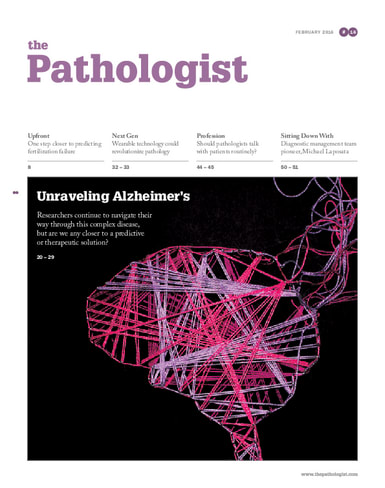Rolling With the Punches
February 25, 2016
Sitting Down With… Michael Laposata, Chairman of the Department of Pathology at the University of Texas Medical Branch at Galveston, Texas, USA.
1 min read
False


Welcome to the February issue. Our Upfront topics include a genetic basis for IVF failure, viral adaptations that cause pandemics, and a new method of resolving detailed 3D cell structures. Our Feature explores the depths of Alzheimer’s disease and what’s being done to promote prevention, early detection and treatment. NextGen looks at wearable telepathology devices, models for personalized medicine, and new diagnostic technologies for rare genetic disorders and common cervical cancers. In Profession, we discuss direct contact between pathologists and patients, and we Sit Down With Michael Laposata, Chairman of the Department of Pathology at the University of Texas Medical Branch at Galveston, Texas, USA.
February 25, 2016
Sitting Down With… Michael Laposata, Chairman of the Department of Pathology at the University of Texas Medical Branch at Galveston, Texas, USA.
1 min read
February 25, 2016
What labs need to know about the importance of ISO 15189 accreditation
1 min read
February 25, 2016
Pathologists play a significant role in patient care – and part of that role should involve speaking to patients about their diagnoses
1 min read
February 25, 2016
A device that uses electrical impedance spectra to characterize abnormal cervical tissue may improve on the subjective nature of colposcopy and reduce the rate of cervical biopsy
1 min read
February 25, 2016
Testing for cathepsin C in urine samples may offer a quicker, cheaper way of diagnosing Papillon-Lefèvre syndrome
1 min read
February 25, 2016
Kinetic models allow researchers to integrate multiple physiological responses into a single test that predicts patients’ likelihood of drug side effects
1 min read
February 25, 2016
Wearable devices show promise for improving pathology workflow
1 min read
February 25, 2016
When Ewan McNay was eight years old, he decided that he wanted to do two things: live forever and find out how the brain works. The secret to eternal life is a work in progress, but his research on insulin resistance in the brain has added a new dimension to our understanding of Alzheimer’s disease.
1 min read
February 25, 2016
Michela Gallagher was studying aging in lab rats when an unusual finding launched her on a translational journey that now sees her poised to initiate a Phase III trial of a drug to delay the onset of Alzheimer’s dementia.
1 min read
February 25, 2016
James Connor’s interest in iron’s influence on neurodegenerative disease was ignited during his postdoctoral training. Since then, he has led teams who have pioneered the field of iron in neurobiology. His research has unearthed the most prevalent genetic mutation in a subset of Alzheimer’s patients and his continued discoveries in genetic and environmental interactions in Alzheimer’s could one day support the early diagnosis, and even the prevention, of the disease.
1 min read
Dive deeper into the world of pathology. Explore the latest articles, case studies, expert insights, and groundbreaking research.
False
False
False